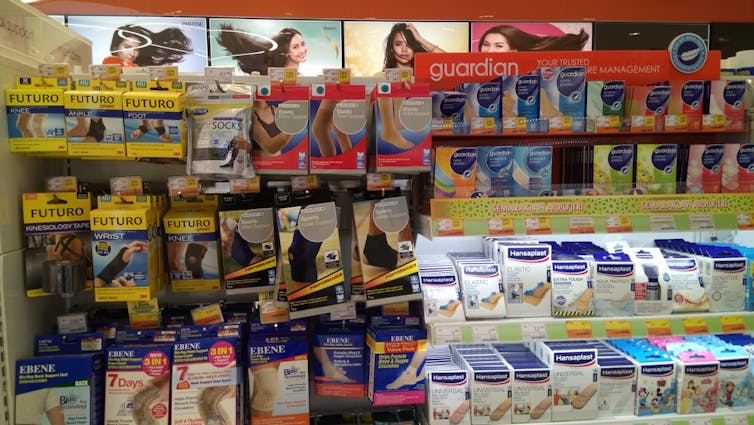Source: The Conversation (Au and NZ) – By Anthony Scott, Professor, University of Melbourne
Federal Health Minister Greg Hunt recently ruled out GP patients having to pay for bandages and dressings, despite a major Medicare review recommending it.
We won’t be putting in place extra charges for patients. I am ruling that out.
Hunt was commenting on a recommendation from the Medicare Benefits Schedule Review Taskforce to charge bulk-billed patients for bandages and dressings. The idea was to save patients some money at the pharmacy, where such products can be expensive. The recommendation also addressed some GPs’ concerns they were out of pocket by supplying these items. However, some people had called the recommendation to charge patients a “band-aid tax”.
Rather than charging patients, Hunt said he’d discuss “alternative sources of government support” for general practices and doctors to supply these items. Here are some options and what they could mean for you.
A thin end of the wedge?
Since 2015, the taskforce has been reviewing about 5,700 items on the Medicare Benefits Schedule to see which services you receive at your GP or specialist align with current evidence and practice, are safe and might benefit you.Of its 1,400 or more recommendations, this one initially seems to be the thin end of the wedge. What would GPs charge you for next? Using equipment to take your blood pressure? The paper your bill is printed on? Luckily, separate charges for such items are illegal.
Read more: Medicare review must deal with ‘elephant in the room’ incentives
GPs can already choose to charge any amount for a consultation. And you would presume all GPs’ costs — including rent for their premises, equipment, office chairs, as well as consumables such as bandages and dressings — are considered when they decide on the level of fee to charge, or whether to bulk-bill. If the costs of supplies are increasing, then GPs can simply increase the consultation fee.
The recommendation also seemed inconsistent with the objectives of the review. This included trying to simplify the Medicare Benefits Schedule (not making it more complicated). The recommendation also seemed inconsistent with strong recommendations aimed at reducing patients’ out-of-pocket costs and making health care more affordable.
What was the taskforce thinking?
The taskforce argued people with chronic wounds, such as venous leg ulcers, often paid a lot for wound dressings they used at home.
Though GPs and practice nurses help dress wounds, patients still need to regularly manage and dress wounds themselves at home. So the taskforce was arguing these costs should be subsidised.
Read more: Curious Kids: how do wounds heal?
The recommendation to allow GPs to charge patients was where the consultation was bulk-billed. This seemed to assume this would be cheaper for patients rather than them buying their own dressings from pharmacies and supermarkets. So the intention was to reduce out-of-pocket costs overall.
However, this recommendation relies on GPs charging patients less than what pharmacies or supermarkets may charge and GPs would not try to profit from selling dressings to patients. However, the taskforce presented no evidence or data to show this would be the case, even though its recommendations are supposed to be evidence-based.

Managing wounds well has both health and economic benefits
Inadequate wound care can have debilitating effects and adversely influence people’s mobility and quality of life. Like any health-care treatment, keeping out-of-pocket costs low for patients can help improve access to health care and improve health outcomes. The issue is how to do this.
Treatment is also highly cost-effective. For instance, providing compression therapy products, such as compression bandages for leg ulcers, would cost the health system an additional A$270 million over five years. But it would save about $1.4 billion over the same period.
So it seems to make sense for new policies to try and reduce the costs GP practices and patients face for these supplies.
How do we reduce the costs?
Centralise purchasing
GP practices and pharmacies buy their supplies on the open market, and small GP practices may not be able to get good deals.
So the taskforce also recommended a Commonwealth-funded wound consumables scheme to centralise purchasing and price negotiation, as is done for medical devices and pharmaceuticals at the Commonwealth level. The idea is to keep prices low.
Offer discounts
Certain patients with chronic wounds could also be eligible for heavily discounted dressings from their pharmacy, though this may be difficult for less-mobile patients. GPs could “prescribe” which dressings are needed and for how long, and the pharmacies could “dispense” these for patients from the wound consumables scheme.
Rethink dispensing
GPs could also dispense these dressings themselves. For eligible patients who are not mobile and cannot easily visit pharmacies, GPs could provide and apply dressings for chronic wounds in the practice (or through practice nurses visiting patients at home). GPs could also provide dressings for patients to apply at home. Providing dressings at home or in the GP practice would require additional payments to general practices from Medicare.
This payment would need to provide incentives for GPs to manage the wounds more effectively and to buy high-quality, low-cost dressings, perhaps purchased via the wound consumables scheme.
What needs to happen?
For patients with chronic wounds that need long-term care (not just people wanting a band-aid), reducing the costs of bandages and dressings is likely to improve access and improve outcomes.
Examining the regulation of these markets could be a first step to ensure prices are as low as possible. This could include considering more centralised purchasing, followed by considering additional funding to subsidise these very cost-effective treatments.
– ref. Should GPs charge for bandages or dressings? Hunt says no to ‘band-aid tax’. So here are some other options – https://theconversation.com/should-gps-charge-for-bandages-or-dressings-hunt-says-no-to-band-aid-tax-so-here-are-some-other-options-154177







